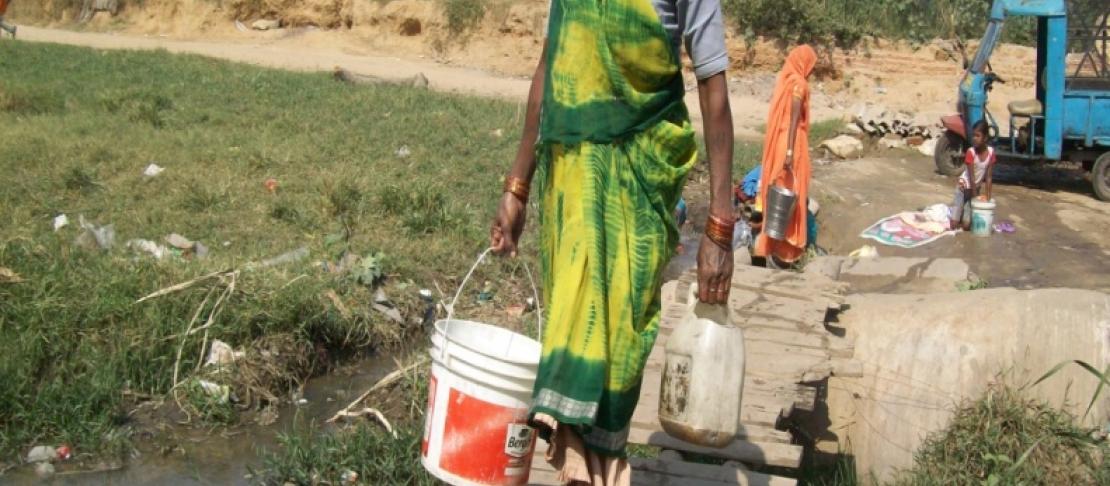Climate change and household water insecurity in India: A case of gender inequalities

By Savita Aggarwal
Many regions in India are characterized by water scarcity which affects the well-being of millions of the poorest people. In India as well as many other developing countries, 20% households still do not have provision of adequate water for domestic use. This has resulted in a significant loss of time and effort, especially on the part of women, who most often have to bear the burden of water collection. The female children have to share the temporal and physical burden of carrying water, often leading to very large gender gaps in school attendance in many countries. Translating the losses borne by girls and women in terms of man (woman) hours and economics shows a loss of human capital and reduction in the ability of the household to capitalize fully on its other resources.
Climatic change, associated with increasing population, urbanization and industrialization, is projected to reduce per capita water availability in many parts of India. The per capita availability of water was 5177 m3/capita/year in 1951. This value has drastically reduced to 1654 m3/capita/year in 2007 and is likely to further go down to below 1140 m3/year by 2050. While the per capita availability of water is decreasing, the gross demand for water is likely to rise due to growing population and affluence.
A water management index called Climate Vulnerability Index for Water at the Household level (CVI-WH) was computed to assess the level of water and climatic insecurity faced by the women in different states of India. CVI-WH consists of six components: ‘resources’ which reflect on the physical availability of water, ‘access’ and ‘use’ components reflecting on the access of families to safe water within approachable distance as well as use of water for domestic, industrial and agricultural purposes. The other components are ‘capacity’ or the ability of people to lobby for and manage water, the ‘environment’ component which has a propound impact on the quality of available water and lastly the ‘climate’ component characterized by percent area prone to droughts and floods as well as the annual temperature rise over time (for detailed methodology refer to Sullivan et.al. 2002, 2009).
An analysis of Climate Vulnerability Index for 2000 and for 2025 for India showed that the climatic vulnerability to water at the household level is projected to decrease from 0.54 in the year 2000 to 0.42. In terms of various components of vulnerability, inadequate access is likely to be completely wiped out by 2025, and there is likely to be tremendous growth in various components of human development, reducing the vulnerability of people to “Low Capacity”. There will be a moderate reduction in vulnerability in the “Use” component accompanied by slight reduction in vulnerability in the “Environment “component. On the other hand, in India, the vulnerability is likely to increase marginally in “Resources” because of population growth and lower per capita availability, but it will increase substantially in the “Climatic stress “component. As a result of the interaction between the six components defining vulnerability of people to climatic and water-related stresses at the household level, there is likely to be overall reduction in vulnerability of India in 2025 as compared to vulnerability in the year 2000. However, India will remain moderately vulnerable to climatic and water-related stresses despite development efforts in different sectors.
Since independence, there has been a gender gap in literacy in India of the order of 20–25 percentage points. However, there is regional variation in male: female literacy rate among states in India. Our analysis revealed that the states with high gender gaps in education of the order of 25–30%, such as Bihar, Uttar Pradesh, and Madhya Pradesh, were among the most vulnerable states to climate- and water-related stresses. By comparison, Kerala had the least gender differential in literacy of a little more than 6% and was among the least vulnerable states. The data clearly showed that the more a state invests in education of girls and women, the more the likelihood of reduced vulnerability of people to climatic and water-related stresses because of higher adaptive capacities.
More information
Read more about Climate Change, Agriculture and Food Security work in South Asia.
This blog post was written by Savita Aggarwal, Department of Development Communication and Extension, Institute of Home Economics, University of Delhi For more information about this topic, download India’s Second National Communication (PDF).
To get more updates on our research in South Asia follow us on Facebook and Twitter @Cgiarclimate.